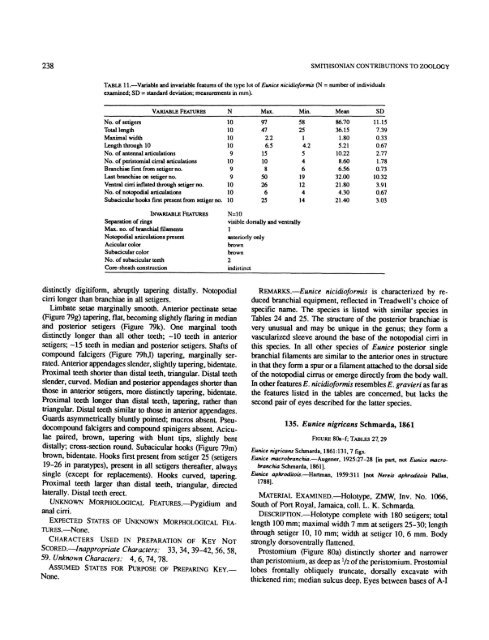A Review of the Genus Eunice - Smithsonian Institution Libraries
A Review of the Genus Eunice - Smithsonian Institution Libraries
A Review of the Genus Eunice - Smithsonian Institution Libraries
Create successful ePaper yourself
Turn your PDF publications into a flip-book with our unique Google optimized e-Paper software.
238 SMITHSONIAN CONTRIBUTIONS TO ZOOLOGY<br />
TABLE 11.—Variable and invariable features <strong>of</strong> <strong>the</strong> type lot <strong>of</strong> <strong>Eunice</strong> nicidi<strong>of</strong>ormis (N = number <strong>of</strong> individuals<br />
examined; SD = standard deviation; measurements in mm).<br />
VARIABLE FEATURES<br />
N<br />
Max.<br />
Mm.<br />
Mean<br />
SD<br />
No. <strong>of</strong> setigers<br />
Total length<br />
Maximal width<br />
Length through 10<br />
No. <strong>of</strong> antcnnal articulations<br />
No. <strong>of</strong> peristomial cirral articulations<br />
Branchiae first from setiger no.<br />
Last branchiae on setiger no.<br />
Ventral cirri inflated through setiger no.<br />
No. <strong>of</strong> notopodial articulations<br />
Subacicular hooks first present from setiger no.<br />
10<br />
10<br />
10<br />
10<br />
9<br />
10<br />
9<br />
9<br />
10<br />
10<br />
10<br />
97<br />
47<br />
2.2<br />
6.5<br />
15<br />
10<br />
8<br />
50<br />
26<br />
6<br />
25<br />
58<br />
25<br />
1<br />
4.2<br />
5<br />
4<br />
6<br />
19<br />
12<br />
4<br />
14<br />
86.70<br />
36.15<br />
1.80<br />
5.21<br />
10.22<br />
8.60<br />
6.56<br />
32.00<br />
21.80<br />
4.30<br />
21.40<br />
11.15<br />
7.39<br />
0.33<br />
0.67<br />
2.77<br />
1.78<br />
0.73<br />
10.32<br />
3.91<br />
0.67<br />
3.03<br />
INVARIABLE FEATURES<br />
Separation <strong>of</strong> rings<br />
Max. no. <strong>of</strong> branchial filaments<br />
Notopodial articulations present<br />
Acicular color<br />
Subacicular color<br />
No. <strong>of</strong> subacicular teeth<br />
Core-sheath construction<br />
N=10<br />
visible donally and ventrally<br />
1<br />
anteriorly only<br />
brown<br />
brown<br />
2<br />
indistinct<br />
distinctly digitiform, abruptly tapering distally. Notopodial<br />
cirri longer than branchiae in all setigers.<br />
Limbate setae marginally smooth. Anterior pectinate setae<br />
(Figure 79g) tapering, flat, becoming slightly flaring in median<br />
and posterior setigers (Figure 79k). One marginal tooth<br />
distinctly longer than all o<strong>the</strong>r teeth; -10 teeth in anterior<br />
setigers; -15 teeth in median and posterior setigers. Shafts <strong>of</strong><br />
compound falcigers (Figure 79h,l) tapering, marginally serrated.<br />
Anterior appendages slender, slightly tapering, bidentate.<br />
Proximal teeth shorter than distal teeth, triangular. Distal teeth<br />
slender, curved. Median and posterior appendages shorter than<br />
those in anterior setigers, more distinctly tapering, bidentate.<br />
Proximal teeth longer than distal teeth, tapering, ra<strong>the</strong>r than<br />
triangular. Distal teeth similar to those in anterior appendages.<br />
Guards asymmetrically bluntly pointed; mucros absent. Pseudocompound<br />
falcigers and compound spinigers absent. Aciculae<br />
paired, brown, tapering with blunt tips, slightly bent<br />
distally; cross-section round. Subacicular hooks (Figure 79m)<br />
brown, bidentate. Hooks first present from setiger 25 (setigers<br />
19-26 in paratypes), present in all setigers <strong>the</strong>reafter, always<br />
single (except for replacements). Hooks curved, tapering.<br />
Proximal teeth larger than distal teeth, triangular, directed<br />
laterally. Distal teeth erect.<br />
UNKNOWN MORPHOLOGICAL FEATURES.—Pygidium and<br />
anal cirri.<br />
EXPECTED STATES OF UNKNOWN MORPHOLOGICAL FEA-<br />
TURES.—None.<br />
CHARACTERS USED IN PREPARATION OF KEY NOT<br />
SCORED.—Inappropriate Characters: 33, 34, 39-42, 56, 58,<br />
59. Unknown Characters: 4,6, 74, 78.<br />
ASSUMED STATES FOR PURPOSE OF PREPARING KEY.—<br />
None.<br />
REMARKS.—<strong>Eunice</strong> nicidi<strong>of</strong>ormis is characterized by reduced<br />
branchial equipment, reflected in Treadwell's choice <strong>of</strong><br />
specific name. The species is listed with similar species in<br />
Tables 24 and 25. The structure <strong>of</strong> <strong>the</strong> posterior branchiae is<br />
very unusual and may be unique in <strong>the</strong> genus; <strong>the</strong>y form a<br />
vascularized sleeve around <strong>the</strong> base <strong>of</strong> <strong>the</strong> notopodial cirri in<br />
this species. In all o<strong>the</strong>r species <strong>of</strong> <strong>Eunice</strong> posterior single<br />
branchial filaments are similar to <strong>the</strong> anterior ones in structure<br />
in that <strong>the</strong>y form a spur or a filament attached to <strong>the</strong> dorsal side<br />
<strong>of</strong> <strong>the</strong> notopodial cirrus or emerge directly from <strong>the</strong> body wall.<br />
In o<strong>the</strong>r features E. nicidi<strong>of</strong>ormis resembles E. gravieri as far as<br />
<strong>the</strong> features listed in <strong>the</strong> tables are concerned, but lacks <strong>the</strong><br />
second pair <strong>of</strong> eyes described for <strong>the</strong> latter species.<br />
135. <strong>Eunice</strong> nigricans Schmarda, 1861<br />
FIGURE 80a-f; TABLES 27,29<br />
<strong>Eunice</strong> nigricans Schmarda, 1861:131, 7 figs.<br />
<strong>Eunice</strong> macrobranchia.—Augcner, 1925:27-28 [in part, not <strong>Eunice</strong> macro -<br />
branchia Schmarda, 1861].<br />
<strong>Eunice</strong> aphroduois.—HitVman, 1959:311 [not Nereis ophrodilois Pallas.<br />
1788].<br />
MATERIAL EXAMINED.—Holotype, ZMW, Inv. No. 1066,<br />
South <strong>of</strong> Port Royal, Jamaica, coll. L. K. Schmarda.<br />
DESCRIPTION.—Holotype complete with 180 setigers; total<br />
length 100 mm; maximal width 7 mm at setigers 25-30; length<br />
through setiger 10, 10 mm; width at setiger 10, 6 mm. Body<br />
strongly dorsoventrally flattened.<br />
Prostomium (Figure 80a) distinctly shorter and narrower<br />
than peristomium, as deep as x /i <strong>of</strong> <strong>the</strong> peristomium. Prostomial<br />
lobes frontally obliquely truncate, dorsally excavate with<br />
thickened rim; median sulcus deep. Eyes between bases <strong>of</strong> A-I
















